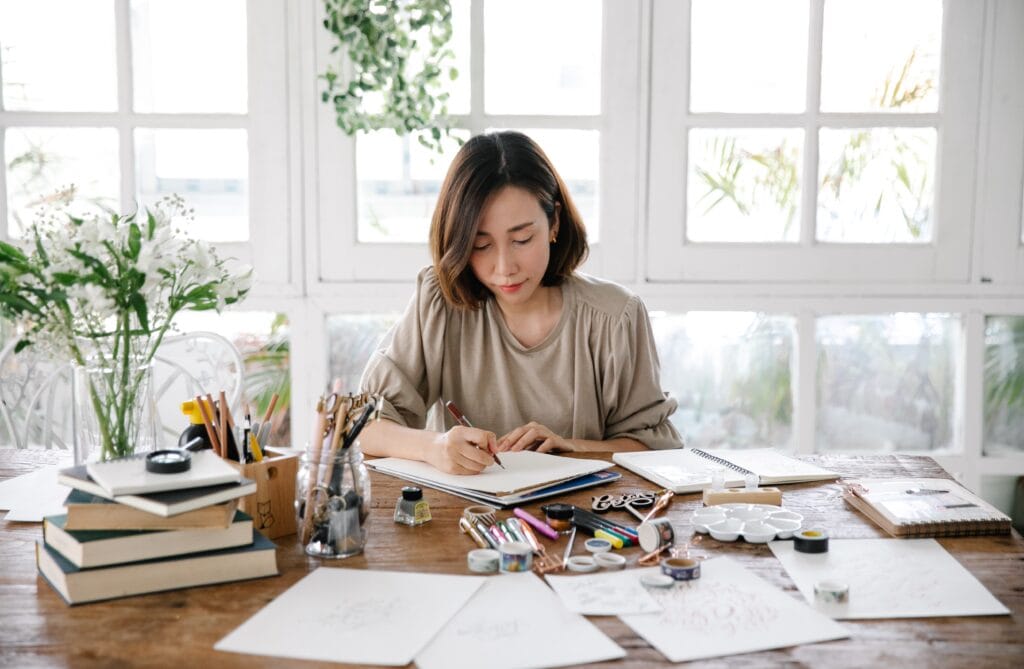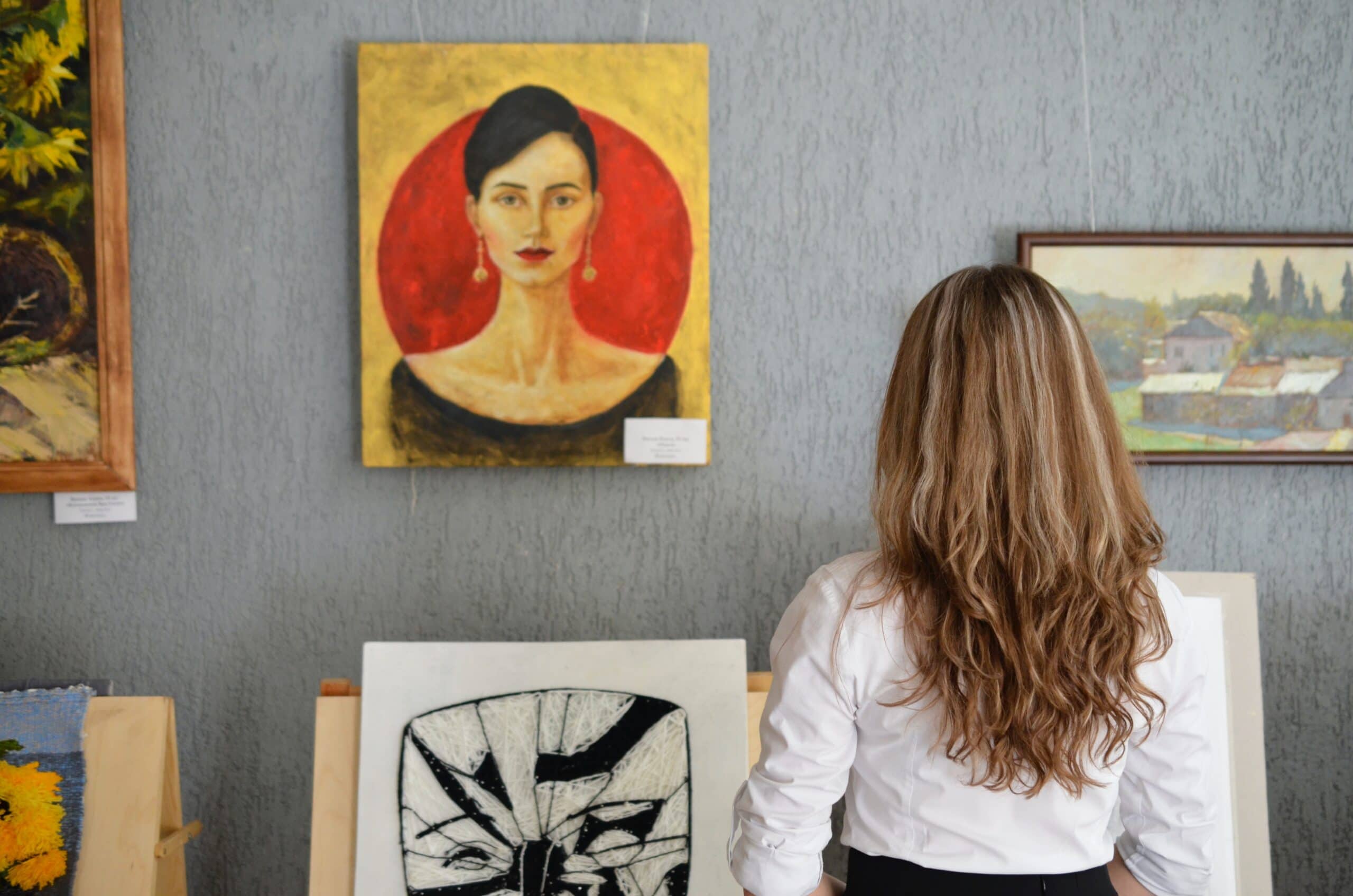Your artist statement is a fundamental piece of writing in your art career, so it is important to invest a good focused time on producing your artist statement.

You may draft an artist statement for each meaningful artwork you produce,
or you can have an artist statement that represents the underlying theme for all of your work.
It is typically used in exhibitions, your artist website, grant applications, art fair display, galleries, press releases, fellowships, and many more.
Additionally, it can serve as a marketing tool for galleries, collectors, and other stakeholders to get in touch with you.
What is an Artist Statement?
Your artist statement is a concise description of your work that bridges your audience to your art. It explains your creative process, motivations, influences, inspirations, medium, and technique.
The purpose of your artist statement is to help viewers and potential buyers (your audience) understand and appreciate your artwork on a deeper level.
👀 After reading your artist statement, the goal is for your audience to begin looking at your artwork with fresh eyes, as your artist statement gave them a new appreciation and understanding of the inspirations and meaning behind your art pieces.
Who is your “audience”?
To put it simply, your audience is anyone who might be a potential buyer of your artwork.
But if you have a target audience in mind, it’s important that you tailor your artist statement in such a way that your audience can relate to and easily understand it.
Some potential audiences for an artist statement may include:
✔️ Art Critics, Curators, and Historians
These individuals look at the artist statement to gain more context when writing or analyzing an artist’s work.
They may refer to the artist statement to understand the creative process and the underlying philosophy behind the pieces.
✔️ Gallery Owners and Art Dealers
These people refer to the artist statement to determine the suitability of the pieces for the gallery. They may need the statement to effectively promote and market the pieces.
✔️ Peers and Fellow Artists
Your artist statement can also open up important collaborations with different artists.
Fellow artists may refer to your artist statement to determine your artistic approach and creative process, which will then be the groundwork for all artistic discussions and critique sessions.
✔️ General Public
We all know that art can connect to people beyond words can explain…
Therefore, even people outside the artistic community can be potential buyers.
Your artist statement can serve as a window to your personal creative world where people can foster a deeper connection to your work.
Artist Statement vs. Artist Bio
| ARTIST STATEMENT | ARTIST BIO |
| ✔️ Provides insight into an artist’s medium and creative process, influences and inspirations, and conceptual framework and philosophy ✔️ Helps potential buyers understand and appreciate the artwork on a deeper level ✔️ Explains the artist’s artistic vision, philosophy, and the concepts they explore in their work. It may also discuss the artist’s techniques, materials, and methods of working, as well as their goals and intentions for their art ✔️An artist statement is usually written in the first person, reflecting the artist’s unique voice and perspective | ✔️ Provides a summary of an artist’s background, achievements, and career highlights ✔️ Often used for promotional purposes and aims to provide an overview of the artist’s professional background and credentials ✔️It may include information such as the artist’s education, training, exhibitions, awards, collections, and other relevant professional experiences ✔️ An artist bio is typically written in the third person |
How to write an artist statement
Do not expect that your artist statement will be ready from the get-go.
It will take some time for you to produce that artist statement that really speaks to your audience. It might take multiple revisions and fine-tuning to have a finished, concise, and compelling written product.
When writing your Artist Statement, remember these steps:
✔️Get to the point
Brevity is the key. Form simple sentences in order for the readers to retain the information better.
✔️ Write then rewrite
Rarely will you produce a written output that is good to go on the first draft.
Be kind to yourself and expect that the 1st draft is not going to be very good and polished.
By allowing yourself to write and rewrite, you will be able to eventually produce a piece that is inspired and in tip-top shape.
✔️ Avoid passive voice
Using passive voice makes the sentence weaker and makes it harder to retain the main point of the sentence. On the other hand, sentences using the active voice are easier to follow and digest.
Active voice: The subject of the sentence is performing the action.
For example, I painted the masterpieces you saw in the gallery.
Passive voice: The action is received by the subject. In these sentences, the focus is on the action itself and not on the doer of the action. And this is why these draw the attention away from the author.
For example, The masterpieces you saw in the gallery were painted by me.
✔️ Provide Context and Reference other artists only when necessary.
It is OK to mention the inspiration behind your work, but remember to draw attention back to your work. Create images for the reader, even if they are unfamiliar with the referenced artist.
Mention the work of that artist that inspired yours: explain the ideas, themes, creative process, materials used, and concepts that spoke to you and how those contributed to the foundation of your artwork.
✔️ Write in the first person and use your unique voice.
Use your own voice when writing the artist statement to make the tone more genuine and sincere. Dig deeper, and do not be afraid to show your personality.
After all, your unique self, experiences, and influences are what made the artwork whole.
Aim for clear, concise, and engaging language that reflects your unique artistic perspective.
✔️ Avoid artspeak—do not alienate your audience.
An effective artist statement conveys the message successfully not only to the members of the art community but to the general public as well. In order to sound more relatable, you want to use language and terminologies that are easy to understand.
Avoid the use of jargon that only art enthusiasts would know.
Structure
Like any other piece of writing, the flow of ideas plays an important role in being able to retain important information. Here is where effective storytelling with solid structure comes into play.
Your artist statement should have a beginning, middle, and end.
✔️ Start from the beginning
Just like when you’re telling a story, you want to start from what happened first. Begin with a clear and concise introduction that catches the reader’s attention and gives an overview of your artistic journey/practice.
✔️ Talk about your medium
Ask yourself:
- How did I make this?
- What was my process? Was it trial and error?
- What is the concept behind my work?
- What are my artistic style/techniques, themes, and influences?
✔️ Talk about your motivations and inspirations
This is where you can reference other artists’ work. Ask yourself:
- How has their work inspired me?
- What concepts spoke to me, and how do I apply those to my own practice and artworks?
- What is the main underlying philosophy behind all of my work? What is my main message?
Remember that your job is not to convince or debate. You only need to communicate and let your art do all of the talking.
✔️ End it with a short summary of your artistic practice
Think about the one thing you want your readers to retain. You can also invite readers to connect with your work through your contact information.
How to begin writing the artist statement
Treat writing your artist statement as a thoughtful and introspective process where you can really know more about yourself and your art.
Here are some recommendations for how to begin writing it:
✔️ Ask a close friend to interview you
If you are not a fan of writing, sometimes it can be difficult to find the right words to describe what you really want to say. Good news, you may find exactly what you want to say by actually saying it.
We recommend supplying a friend with questions you want to include in your art statement and recording your answers. Then, listen to it and take down the sincere, honest, and genuine answers you want to include in your artist statement.
✔️ Reflect on your work
It is a good practice to spend some time reflecting on your work and thinking about the creative process and inspirations behind each one of them. Also, reflect on the uniqueness of each artwork and the message you want to communicate to your audience.
✔️ Think about your roots
Your culture and heritage can also be the main influencers of your work. Take some time to think about how your upbringing and culture inspired your art, then ask yourself if you want to include this piece in your art statement.
✔️ Mull over some social issues and your political stance
If you are an artist who draws inspiration from certain social and political causes, you may want to think about the main cause that inspires most of your artwork.
But again, remember that the goal of your artist statement is not to change people’s perspectives and fight with them in doing so but to communicate your passions and inspirations, hoping that the artwork itself speaks to the audience.
✔️ Spend some time in nature
A lot of artists draw inspiration from nature, and being in nature sometimes gives you new perspectives and clarity. You want to be in a peaceful state in order to put your thoughts on paper.
Truly, writing the artist statement can be intimidating at first. But remember that in the process of writing it, you’ll surely discover more about yourself and your art.


a timely Godsend, I've been going through the process of creating a website with a student who is a bit shy with feedback, so this ' artists statement ' can in effect be my content ..
Nice article, now I have a better understanding of how I might use several layers of Artist Statements to paint a word picture of the different styles I paint as well as the different paintings.